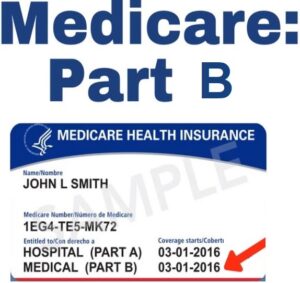 What is Medicare Part B? What does it cover? Many individuals perceive it as medical coverage, but it actually encompasses both inpatient and outpatient services. Consider Part B coverage as any medical care provided by physicians. Medicare Part B grants you access to a wide range of outpatient medical services. It includes preventive care like flu shots, colonoscopies, mammograms, and more. Additionally, it covers routine outpatient services such as doctor’s visits, laboratory tests, home health care, ambulance rides, and even certain chiropractic care.
What is Medicare Part B? What does it cover? Many individuals perceive it as medical coverage, but it actually encompasses both inpatient and outpatient services. Consider Part B coverage as any medical care provided by physicians. Medicare Part B grants you access to a wide range of outpatient medical services. It includes preventive care like flu shots, colonoscopies, mammograms, and more. Additionally, it covers routine outpatient services such as doctor’s visits, laboratory tests, home health care, ambulance rides, and even certain chiropractic care.
However, Medicare Part B also extends its coverage to services that are occasionally rendered within a hospital setting. This includes physician services, radiation or chemotherapy for cancer treatment, surgeries, diagnostic imaging, medical equipment, and even dialysis for individuals with failing kidneys. Part B also caters to the expenses of drugs administered in a clinical environment, such as osteoporosis injections, infused drugs, antigens, and insulin used with an insulin pump. On the other hand, outpatient drugs are covered under Part D. While Part B is optional, it is essential if Medicare is your primary coverage. Moreover, you cannot obtain Medigap supplemental coverage without enrolling in Part B.
COVERED BY PART B
PART B BENEFITS INCLUDE
Not Covered by Part B
- DENTAL , VISION & HEARING
- HOSPICE CARE
- PRESCRIPTION DRUGS
What expenses are covered by Medicare under Part B?
After you have paid the annual deductible, you will be eligible for coverage of 80% of the approved costs.
How Much Will I Pay for Medicare Part B?
To receive your Medicare Part B benefits, a monthly premium is required. The majority of Americans will pay the standard monthly amount determined by the government. For individuals new to Medicare in 2024, the base rate for Part B is $174.70 per month. However, if your income exceeds a certain level, you may owe a higher amount. To determine the costs based on your income bracket, refer to the chart available on our Medicare costs page. It is crucial not to miss your enrollment window when retiring and losing access to your employer group health insurance, as late enrollment into Part B may result in a lifelong penalty. If you are already enrolled in Social Security income benefits, Medicare will deduct your Part B premiums from your Social Security check. Otherwise, you will receive quarterly invoices for payment. To pay for Part B using a credit card, simply complete the bottom portion of the payment coupon provided on the quarterly invoices and mail it to the Medicare Premium Collection Center. Alternatively, you can opt for Medicare Easy Pay, a convenient auto-draft service that deducts your premium payments monthly from a checking or savings account. This service is free of charge.
How Do I Sign Up for Medicare Part B?
If you are already receiving Social Security income benefits at the age of 65, there is no need for you to go through the enrollment process. The Social Security office will take care of enrolling you automatically, and you can expect to receive your card in the mail 1 – 2 months before your 65th birthday.
However, for those who are not yet receiving Social Security income benefits, it is necessary to apply for Medicare Part B themselves once they reach the age of 65. The application process for Medicare Part B can be completed online, over the phone, or in person at your local Social Security office. Once you have submitted your application, it will take approximately 2 – 3 weeks for your card to arrive. Therefore, it is advisable to apply several weeks in advance to ensure that you have coverage when you need it.
It is important to note that enrolling in Part B during your Initial Enrollment Period is crucial, unless you already have other creditable coverage. Failing to do so may result in a penalty.
Does Medicare Part B Cover Everything Outpatient?
Part B typically encompasses any medical services that are considered essential. Therefore, if a physician records the necessity of a specific procedure, it is generally eligible for coverage. In the event that Medicare disputes the medical necessity as determined by the doctor, additional documentation may be necessary.
What Part B Does not Cover?
Part B excludes hospital expenses that are already covered by Part A. Additionally, it does not provide coverage for cosmetic procedures, routine dental, vision or hearing services, or routine foot care. Moreover, it does not include drugs that can be obtained directly from a retail pharmacy. To obtain coverage for these drugs, you will need to enroll in a Part D drug plan. It is important to note that Part B generally does not cover services that are deemed unreasonable or unnecessary. Your doctor is typically knowledgeable about the coverage rules and can guide you accordingly.
Cost Sharing Under Medicare Part B?
You are responsible for a portion of the expenses incurred for your medically necessary Part B services. Typically, these expenses include:
1. The annual Part B deductible, which amounts to $240 in 2024.
2. 20% of the remaining costs, without any limits or caps.
3. Any additional charges that a provider or facility may impose beyond what Medicare reimburses, known as excess charges.
The most significant aspect is the 20% that you will be required to pay for outpatient medical care. Expenses for services such as surgeries or chemotherapy can accumulate to thousands of dollars. However, there is no need for you to bear these expenses alone, as there are supplementary coverage options available to suit any budget.
The Medicare Part B Late Enrollment Penalty!
If you failed to enroll in Medicare when you were initially eligible and did not have any creditable coverage, you will be required to pay the Medicare Part B late enrollment penalty. This penalty amounts to 10% per year for each year (12 full months) that you delayed enrolling. The penalty is applied to the standard Part B premium, which will be $174.70 in 2024.
Once you decide to enroll, you must wait for the Medicare General Enrollment Period, which takes place from January 1st to March 31st each year, to sign up for Part B. Your benefits will then commence on the 1st of the following month after your application is submitted. This situation can be challenging because not only will you owe a penalty, but you will also have to wait several months for your coverage to become effective.
However, if you were late in enrolling due to having employer group health coverage from a company with 20 or more employees, you will not be subject to the Part B late enrollment penalty. You will have an 8-month window to sign up for Part B once you leave that coverage. This period is known as your Special Enrollment Period for Medicare.
To avoid the Medicare Part B late enrollment penalty altogether, it is advisable to enroll in Medicare during your Initial Enrollment Period.
If you don’t sign up for Medicare Part B at the right time, you could have a lifelong penalty.
Takeaways
Part B not only encompasses outpatient services but also includes coverage for specific medications, preventive care, and select hospital services. To assist in covering your share of cost-sharing with Medicare, you have the option to enroll in either a Medigap or Advantage plan. It is crucial to enroll in Part B at the appropriate time to avoid incurring any late enrollment penalties.
 Mario Arce
Mario Arce
I have been working with Medicare clients since 2016. I serve California members in San Bernardino & Riverside county.


